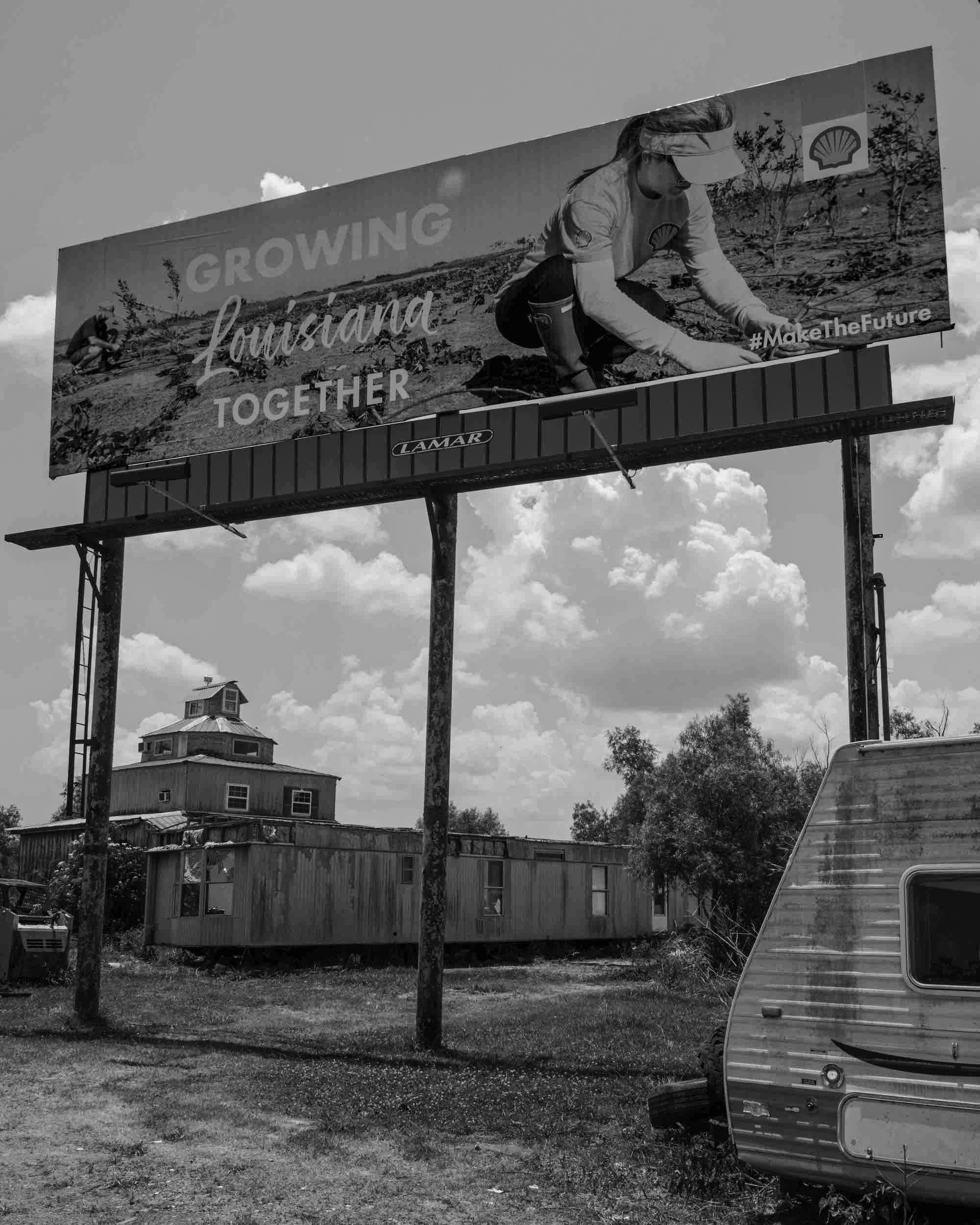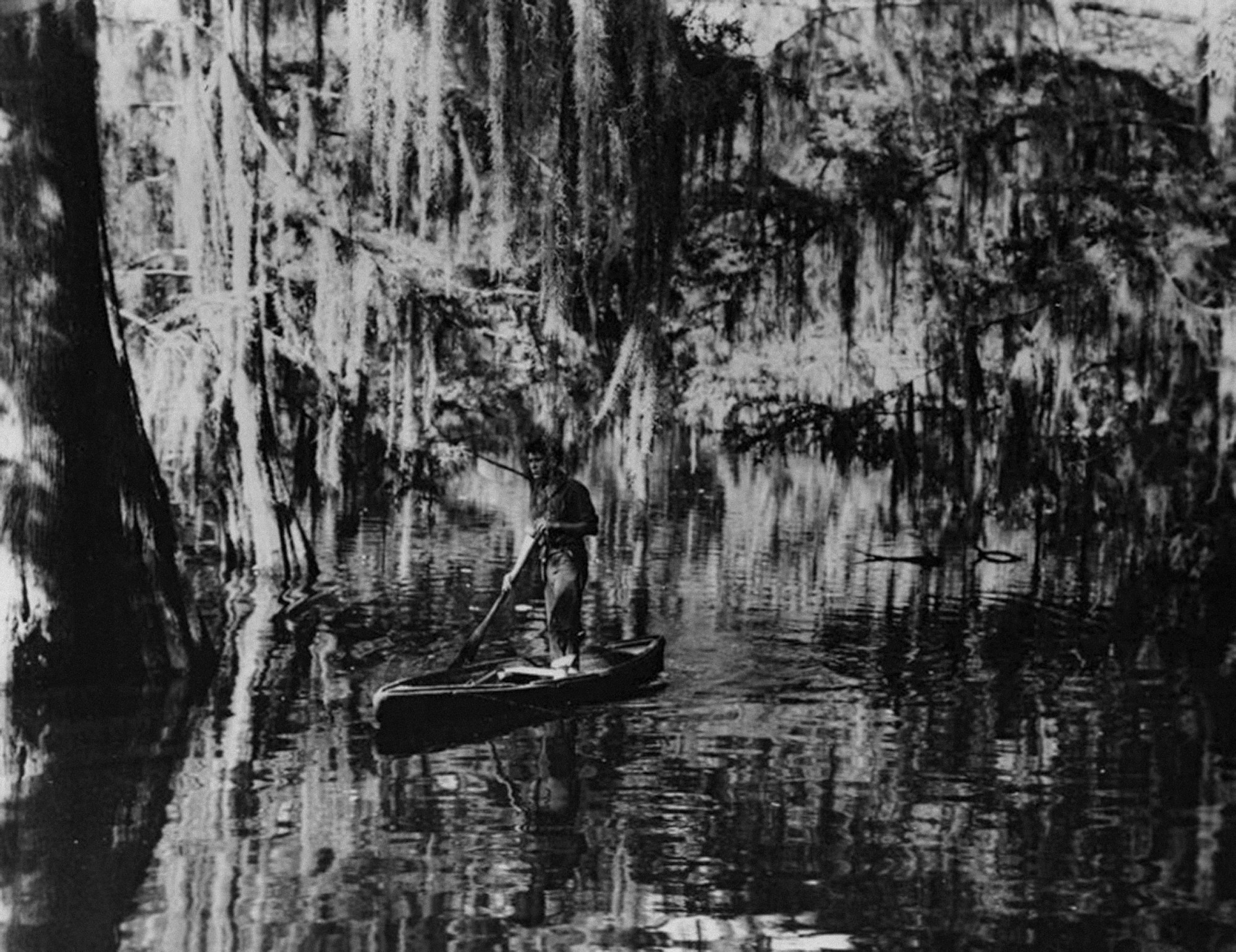A Louisiana Story
By Virginia Hanusik

Photo courtesy Virginia Hanusik
The opening sequence follows a young boy paddling his pirogue through a swamp; midday light breaks through the cypress canopy to highlight the rippling water and swaying Spanish moss. The black-and-white tonal range and dramatic score, written by Virgil Thomson and performed by the Philadelphia Orchestra, envelop the viewer within a lush, harmonious scene.
Robert Flaherty’s 1948 film Louisiana Story is set entirely in the bayous of South Louisiana. Local residents were hired as actors, and the plot revolves around a boy’s family that has allowed an oil company to drill in the inlet that runs behind their house. There is no resistance to the oil seekers, and as the film progresses, the company completes its operation and leaves behind an untouched, pristine environment—and a wealthy, content family.
Louisiana Story received widespread acclaim when it was released, receiving the Pulitzer Prize for Music (still the only film score to do so) and an Academy Award nomination for Best Writing in a Motion Picture Story. The Library of Congress also added the film to the National Film Registry for being “culturally, historically, or aesthetically significant.”
The film was, in fact, culturally significant—but not in all the ways inclusion in the registry may have implied.
In a New York Times review from September 1948, a critic writes: “the intrusion—of an oil-drilling derrick, in this case—only briefly disturbs the serenity of a Louisiana bayou and of a small boy’s life. But, at least, it is recognition that the machine can be a useful friend of man, no more rapacious, in some way, than primitive man or nature themselves.”
In this glowing view of the machine, the critic seems to contribute to the intended purpose of the film: to sway public opinion in favor of the oil industry. The film portrays the industry in a humanitarian light because the project was funded by the Standard Oil Company to promote its drilling ventures in Louisiana’s waterways.
The review continues: “…the interest of Flaherty in the drillers as a type of ‘strong man’ is evident. And the men who play these characters, drillers for the Humble Oil Company in fact, are worthy of this admiration, for they do put on a good show. This may be significant, since the picture was made with money supplied by Standard Oil, but we doubt it. The ring of sincerity is clear in Flaherty’s film.”
Though this critic senses sincerity, I sense only propaganda when I watch Louisiana Story. And when we compare oil’s role in the film with oil’s role in Louisiana’s actual history, we should all have our doubts about how much the industry should be admired. The film portrays the petrochemical industry in symbiotic harmony with nature, ultimately implying that oil’s machinery is a benign force. Scenes of drillers working beside Cajun families perpetuate the myth that there are no environmental consequences of fossil fuel extraction. I find such bucolic scenes difficult to watch, though, when I consider how the oil industry has affected the state. Following the film’s release, the industry spread through Louisiana, across its marshlands and into the Gulf. Instead of perpetuating idyllic harmony, the industry caused coastlines to erode, health disparities to increase, economic inequality to worsen, and communities to become displaced as land disappeared into water. The film, with its award-winning artistry, no doubt contributed to Standard Oil’s successful reach across the region. As a work of propaganda, Louisiana Story proves that romanticizing the future may be even more detrimental than harboring nostalgia for an imagined past.

Still from Louisiana Story
For the better part of the last decade, I have devoted my work as a photographer to counteracting the success of environmental propaganda across southern Louisiana. My images examine the architecture, infrastructure, and landscape of Louisiana to document the histories of landscape valuation and the impacts of devaluation. A distinct visual culture—or lack thereof—of landscape aesthetics influences how a space is seen and used, as we see in early photographs of the American West that were used as expansionist propaganda. But South Louisiana, its wetlands devalued because they can’t be traditionally cultivated, is only minimally represented in the canon of American landscape art. This underrepresentation of inherent beauty and ecological diversity can be tied to the region’s current environmental crisis. This is because the value of this land is derived from the drilling of its resources. My photographs meditate on life in this liminal space where cultural and natural resource extraction meet.
By focusing on human engineering, especially at the hands of the oil industry, my images illuminate how we’ve altered the land through temporary technical measures and how we’ve thus chosen to protect certain communities over others from the increasingly severe impacts of climate change.
Seventy-five years after the release of Louisiana Story, one would imagine that if a similar story were told today, it wouldn’t receive such accolades. However, the messaging of the industry is alive and well even if it isn’t working in film anymore. If you drive west on Highway 90 past Des Allemands in Lafourche Parish, you’ll see a billboard sponsored by Shell that reads GROWING LOUISIANA TOGETHER. It features two people planting trees on what appears to be restored marshland. It is one of many signs across South Louisiana that you may pass if you travel, like thousands of people do every spring, for the New Orleans Jazz and Heritage Festival, also presented by Shell. The industry’s relationship with media and art continues to tell a story of environmental and cultural stewardship. The New Orleans Museum of Art, Ogden Museum of Southern Art, New Orleans Film Festival, and many more of the city’s cultural institutions receive support from foundations funded by the oil and gas industry’s wealth.
Looking forward, the state has a fifty-year, fifty-billion-dollar Coastal Master Plan, which is intended, as its latest edition states, to “preserve coastal Louisiana’s rich culture, ecosystems, and natural resources threatened by ongoing land loss and flood risk.” The initiative is made possible, at least in part, by the Deepwater Horizon oil spill in 2010 that devastated Louisiana’s coastal ecosystems. Over $8 billion from the spill’s criminal settlement was allocated for coastal restoration projects, but the funds are set to run out in 2031. When this happens, the state must find other sources of revenue to preserve what is left of its disappearing coast. It is perhaps then that a story separate from the oil industry might be told.



